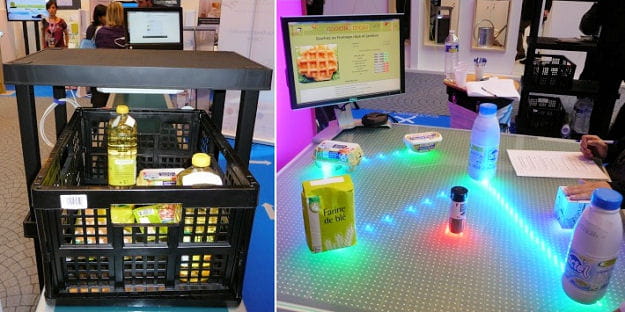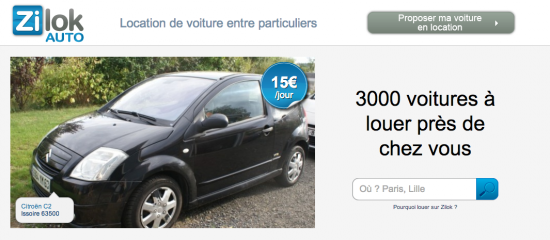wrapped up in Santa Clara today, where 77 startups took the stage to
show off their apps, services and products. The young companies were
given six minutes to pitch their ideas and impress the audience,
collectively competing for the $1 million advertising prize that went to
the idea with the most promise.
From a bird identification app and an “Internet of Things” to
apartment finders and augmented reality, here are the 14 startups that
stood out from the pack during the three-day launch event.
The Winners
 RentLingo
RentLingo,
which was picked as the best of the “Alpha Pitches” given by student
entrepreneurs, began as a simple class project at Stanford. Co-founders
Dan Lauer and Byron Sing interviewed hundreds of tenants, apartment
owners and property managers, during which a pattern emerged. Although
there are scores of sites that allow you to browse apartment listings,
there is no easy way to find information on prospective tenants,
roommates or sublets.
So RentLingo decided to use social networking to make the rental
process less of a pain in the ass and help landlords find great tenants
and renters find the best apartments. To do that, the startup aggregates
info from the major listings players and uses Facebook’s Open Graph to
give users social context as they search for apartments. It presents
this all via a dynamic map UI, giving listings more of a localized feel
and allowing you to see what friends have lived in a particular area and
reach out to them (within the app) to ask questions.
Your friends can then drag and drop a comment about the apartment,
all of which is visible to people within your network and social graph.
The site aggregates and lets you view all of this social sentiment
around each listing, aiming to provide a more effective and relevant
“review” system. Listings with reviews from your network show up as blue
pins, while national listings show up as red pins, all of which can be
easily filtered by price, size, location and recency.
The idea is to turn the platform into a place where owners go to see what renters are saying about them (
a la
Yelp) and to help students and renters find great spots with the help
of their social graph and location targeting. With Padmapper,
Craigslist, Zumper and seemingly hundreds more, it’s a crowded space,
but RentLingo has taken a unique angle that could be powerful at scale.

Austin-based
Ube
(pronounced yoo-bee) took home the “People’s Choice Award” at DEMO
because it plays into our sci-fi-fueled visions of what technology will
do to our homes over the next few decades. The startup is trying to take
the unintuitive and costly world of home technology and make it simple
and cheap, while removing the need for extra hardware or programming.
Ube’s app allows users to easily control IP-enabled smart devices
using their Android or iPhone. This includes smart TVs, set top boxes,
AV receivers, DVD players, thermostats, garage doors openers and more.
You can even use the app to control your devices while you’re away from
home using the Ube Cloud — all you need is a smartphone and a WiFi
router. The company said that its app will work with over 200
IP-controlled devices when it launches next month. Peter covered Ube’s
launch yesterday,
which you can check out here for an in-depth review.
It was also a big day for Rock Health (and healthtech at large), as
two of DEMO’s five winners were part of the health accelerator’s most
recent batch. We covered Rock Health’s third batch here, and
descriptions are included below.
 Neumitra
Neumitra
develops data-driven technologies to address the effects of stress on
health, productivity, and happiness. More specifically, the company is
developing both wearable and mobile tech that uses biosensors to monitor
your autonomic nervous system and the contextual and personal cues that
set off stress. The company collects that data, offering analytics and a
dashboard that highlight key metrics — both for individuals and large
organizations.
At DEMO, Neumitra presented its newest product, Bandu, a smart watch
that helps users reduce stress and “slow down.” Using smart sensors to
identify biometric signals, Bandu monitors your body temperature, motion
and skin conductance. When it finds significant changes in the norm
(i.e. red flags that indicate an increase in stress), the device prompts
you to take a number of mood-altering actions, of the non-narcotic or
barbiturate variety, of course. Sending notifications to your phone,
Bandu might suggest that you play a game, or call a kindly grandmother,
or play some music.
 NeuroTrack
NeuroTrack
is a suite of behavioral assessment tools (software-based
cognitive/visual tests) that can help identify the symptoms and diagnose
Alzheimer’s disease and cognitive impairment up to four years before
their onset. Nerotrack works with pharma companies and researchers to
recruit candidates for clinical trials and to help measure drug
efficacy, thereby speeding up the process of drug development.
DEMO saw the launch of NeuroTrack’s newest product, which aims to
make Alzheimer’s diagnosis more widely accessible by removing the need
to take an eye-tracking test and, instead, simply allows users to take
the test using a mouse or trackpad.
 ElectNext
ElectNext
aims to help anyone and everyone get informed and stay engaged with
important political issues. People are busy and generally stay away from
politics, but apparently our votes count and can help shape policy that
determines how we live our lives — or at least so we’re told. At the
very least, we could all stand to be a little bit more informed. So,
ElectNext aims to make that easy through a little visual Q&A and
some dating dynamics.
The end-goal is to match users with the right politician (the one who
aligns closest with your political views) and does so by prompting them
to choose the three issues that matter to them most. The site then asks
an additional ten questions, using your responses to determine your
political match. If that doesn’t satisfy, users can go through each
question, digging down into the data and compare each politician’s stand
on the particular issue.
Users can then make a donation to their chosen candidate and engage
with them on various networks. Obviously, it’s simple as is, but you can
see this potentially being a useful platform for politicians to engage
their constituency based on issues that matter to them and a way to
disseminate propositions (oh, California), petitions, etc. ElectNext
itself simply wants to create a tool that increases voter participation
in the U.S. Even if this isn’t the way to do it, the goal is an
admirable one. But good luck with the young people, I hear they’re
apathetic.
 Ecolek’s Birdeez
Ecolek’s Birdeez
grew out of a student project at UC Santa Barbara. A bird in the hand
is worth two on your phone, or something. The app, simply put, helps
bird-watchers identify and track whales. No, just kidding, it helps them
track birds they see on their routine bird-watching adventures.
Birdeezows read descriptions of the avian animals you identify, keep
track of all your sightings and even tweet about it. Get it? Tweet?
Warning: This app may not have quite as much utility if you’re an urban
dweller. You can only identify pigeons so many times.
 Flinja
Flinja
is out to help college students and recent grads find jobs — at least
part time. Which is an awesome mission given the un-and-underemployment
epidemic among this age group. Flinja wants to turn college students
into a freelance workforce, offering an eMarketplace in which they can
make themselves available for freelance work. A bit like Zaarly or
TaskRabbit with a twist, students post the services they want to provide
and employers and faculty can book directly. The idea, writ large, is
to give students one place where they can search for jobs and
internships, make connections and build a professional network and make a
few bucks on the side.
Notables
 PassBan
PassBan
— One of my favorite products from DEMO was PassBan, an app that offers
multi-factor verification for your mobile device and more. While there
are a multitude of security apps and password keepers that help keep
devices and sensitive digital info secure, few offer users the ability
to unlock websites and devices by way of voice, motion, facial
recognition, location and token verification.
Users can set up their phones, for example, so that access is granted
only by scanning their glorious visage. On top of that, the app (which
will be available on iOS and Android in the coming months) lets you
choose different levels of security for individual sites or apps, so you
could keep nosey roommates out of your Dropbox account or your Gmail.
Or maybe your son or daughter has been racking up your bill from in-app
purchases in a game on your iPad, in which case you could have PassBan
grant access if and when it hears your voice.
Another cool feature: The app works remotely, so that you could, say,
grant or deny access to websites your progeny is trying to view at home
while you’re at work. Users can pick and choose between voice, face,
location, etc. for different apps and websites or set up a combo of
those on one particular app or website. The startup is currently in beta
and will be launching to the public soon. So stay tuned.
 Bizness Apps
Bizness Apps: We’ve
written about this startup a number of times,
thanks to their simple tools that allow individuals or businesses to
quickly and affordably create their own mobile apps for iOS, Android or
the Web (with HTML5) — even if they don’t have any technical know-how.
While the startup also offers a white-label program for DIY app
development, at DEMO the startup added a new product to its growing
arsenal of tools for the SMB market. The new product, called Bizness
CRM, was initially built internally to help its white-label resellers
sell apps and websites to startups and small businesses. Unable to find a
good third-party product to recommend for those looking to sell to
SMBs, the team turned it into a product.
One of the CRM platform’s key features is a lead generator that
allows users to find leads in any industry, any location and then narrow
that list based off of optional criteria, like “has website” or “has
Twitter page,” etc. Obviously, a small business that has a quality
website and a social media presence is much more likely to invest in a
mobile app if they’ve already seen results from traditional marketing,
so this helps sales teams and marketers save time and narrow the field.
The platform also includes a tracking pipeline, a scheduling
calendar, a metrics dashboard, team collaboration and a native iPhone
app to track sales on the go.

Portland-based
Tellagence
is making a bold claim: The startup believes that it has developed
technology that allows it to predict the flow of content on social
networks — who will share information on any network. Simply put, the
social prediction technology uses algorithms to analyze and measure the
enormous amount of interactions, behavior and changes that take place
every day across social networks.
Not just another social analytics platform, Tellagence instead calls
itself a “conversation monitoring system” that identifies context and
relationship dynamics to predict the path of communication. The goal is
to allow brands and businesses to optimize marketing efforts and
increase reach by moving away from focusing on individual influencers to
targeting smaller, key group of users and their most significant
relationships.
The startup’s first product focuses on Twitter and is geared toward enterprise marketers. For more on the science,
go here.
Ones To Watch
YouBetMe
is an app that lets you challenge your friends (and strangers) to a
wager about anything — at anytime. The app lets you capitalize on all of
life’s betting opportunities, whether it’s on Monday Night Football,
whether your startup will get covered by TechCrunch, how many Jello
shots you can take, etc. Users can also create and confirm bets on the
go through the app’s SMS-based betting platform, tracking betting data
and view public ratings designed to keep bettors honest.
Bonfyre is a
photo and content-sharing app that lets users create private groups to
share with those who matter most (and will find the share relevant).
Those private groups are created around events, which become part of
group photostreams and forums to enable reminiscing, event planning and
good ole realtime mobile sharing.
Blipboard is a
personalized mobile map of the exciting stuff happening around you. The
map surfaces places and events nearby based on the activity and
interests of your friends, influencers and other businesses. Users can
create “blips” or location-based alerts designed to attract others to
the venue. The app is headed to the app store shortly.
Candy Lab’s new
mobile app uses augmented reality to turn the world around you into a
video game — with advertising. The company calls Cachetown a combination
of “Google AdWords, Foursquare, and Super Mario Brothers,” delivering
its game layer in location-based AR.
Top Photo Credit:
Stephen Brashear
 Le bureau R&D du Centre d'innovation des technologies sans contact (CITC) - EuraRFID
a conçu une étagère et une caisse enregistreuse intelligentes. Une puce
RFID étant apposée à chaque article, l'antenne RFID placée au sommet de
l'étagère sait ce qu'elle contient. "De quoi simplifier
considérablement les démarches d'inventaire, mais également informer à
distance les consommateurs de la disponibilité des produits, via un site
Web ou mobile", précise Pauline Fumery, du CITC.
Le bureau R&D du Centre d'innovation des technologies sans contact (CITC) - EuraRFID
a conçu une étagère et une caisse enregistreuse intelligentes. Une puce
RFID étant apposée à chaque article, l'antenne RFID placée au sommet de
l'étagère sait ce qu'elle contient. "De quoi simplifier
considérablement les démarches d'inventaire, mais également informer à
distance les consommateurs de la disponibilité des produits, via un site
Web ou mobile", précise Pauline Fumery, du CITC.
 Autre projet NSE, Idées-3Com
a développé pour Décathlon et Aptonia un prototype d'utilisation
marchande de la TV connectée. Le scénario proposé est le suivant : lors
d'une publicité TV de Décathlon, un bandeau propose au téléspectateur de
se connecter à un programme d'entraînement sportif. La main bascule de
la télécommande au smartphone de l'utilisateur, qui crée son profil,
choisit son sport et son niveau et lance le programme. Pendant qu'il
exécute l'entraînement, s'affichent le nombre de calories brûlées, son
niveau d'hydratation ou encore le nombre d'amis Facebook connectés et
leurs encouragements.
Autre projet NSE, Idées-3Com
a développé pour Décathlon et Aptonia un prototype d'utilisation
marchande de la TV connectée. Le scénario proposé est le suivant : lors
d'une publicité TV de Décathlon, un bandeau propose au téléspectateur de
se connecter à un programme d'entraînement sportif. La main bascule de
la télécommande au smartphone de l'utilisateur, qui crée son profil,
choisit son sport et son niveau et lance le programme. Pendant qu'il
exécute l'entraînement, s'affichent le nombre de calories brûlées, son
niveau d'hydratation ou encore le nombre d'amis Facebook connectés et
leurs encouragements. Critizr Pro voit
apparaître l'information sur sa tablette ou son mobile et peut réagir à
chaud. La solution est déjà installée dans 750 points de vente dont une
grande partie d'indépendants, mais séduit également de grandes enseignes
telles qu'Auchan ou Carrefour : 300 magasins Carrefour en disposeront
d'ici avril prochain. "Critizr a également développé une solution pour
les e-commerçants, précise son fondateur Nicolas Hammer. Nous générons
un QR code lié à la commande du cyberacheteur et joint à son colis." Le
client n'a qu'à le scanner avec l'application Critizr pour arriver
directement sur son compte et renseigner le problème rencontré.
Critizr Pro voit
apparaître l'information sur sa tablette ou son mobile et peut réagir à
chaud. La solution est déjà installée dans 750 points de vente dont une
grande partie d'indépendants, mais séduit également de grandes enseignes
telles qu'Auchan ou Carrefour : 300 magasins Carrefour en disposeront
d'ici avril prochain. "Critizr a également développé une solution pour
les e-commerçants, précise son fondateur Nicolas Hammer. Nous générons
un QR code lié à la commande du cyberacheteur et joint à son colis." Le
client n'a qu'à le scanner avec l'application Critizr pour arriver
directement sur son compte et renseigner le problème rencontré. Web users can already easily take advantage of translation services
that convert text from one language to another, and we’ve also seen
Web users can already easily take advantage of translation services
that convert text from one language to another, and we’ve also seen 
 Hier, le groupe IKEA a dévoilé une nouvelle stratégie ambitieuse de développement durable, baptisée "People & Planet Positive" ou Positif pour les gens & la planète dans laquelle il entend entre autres, obtenir son indépendance énergétique.
Hier, le groupe IKEA a dévoilé une nouvelle stratégie ambitieuse de développement durable, baptisée "People & Planet Positive" ou Positif pour les gens & la planète dans laquelle il entend entre autres, obtenir son indépendance énergétique.

























